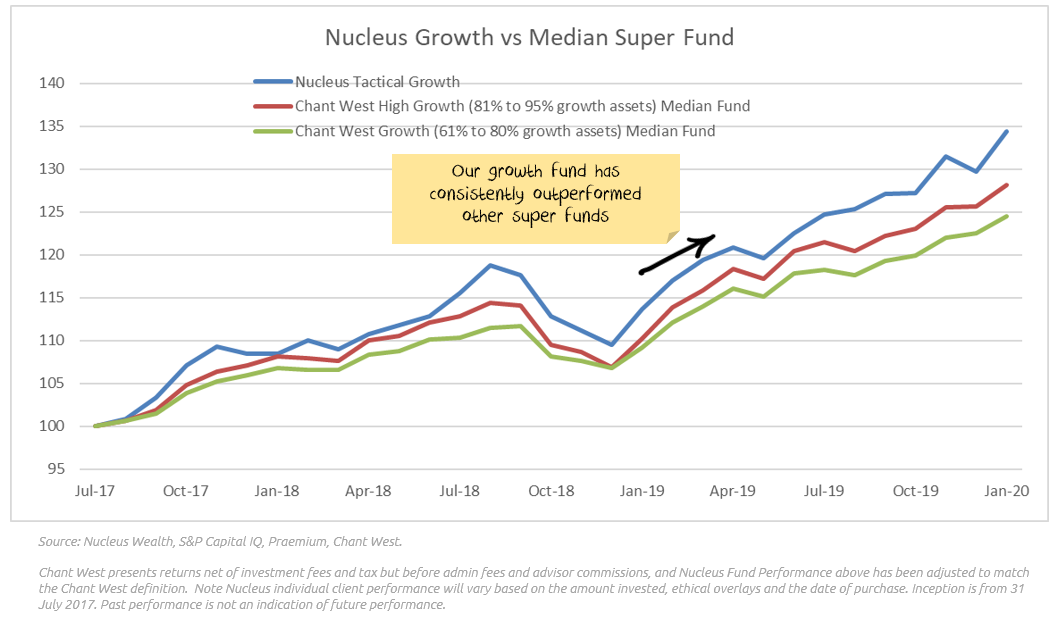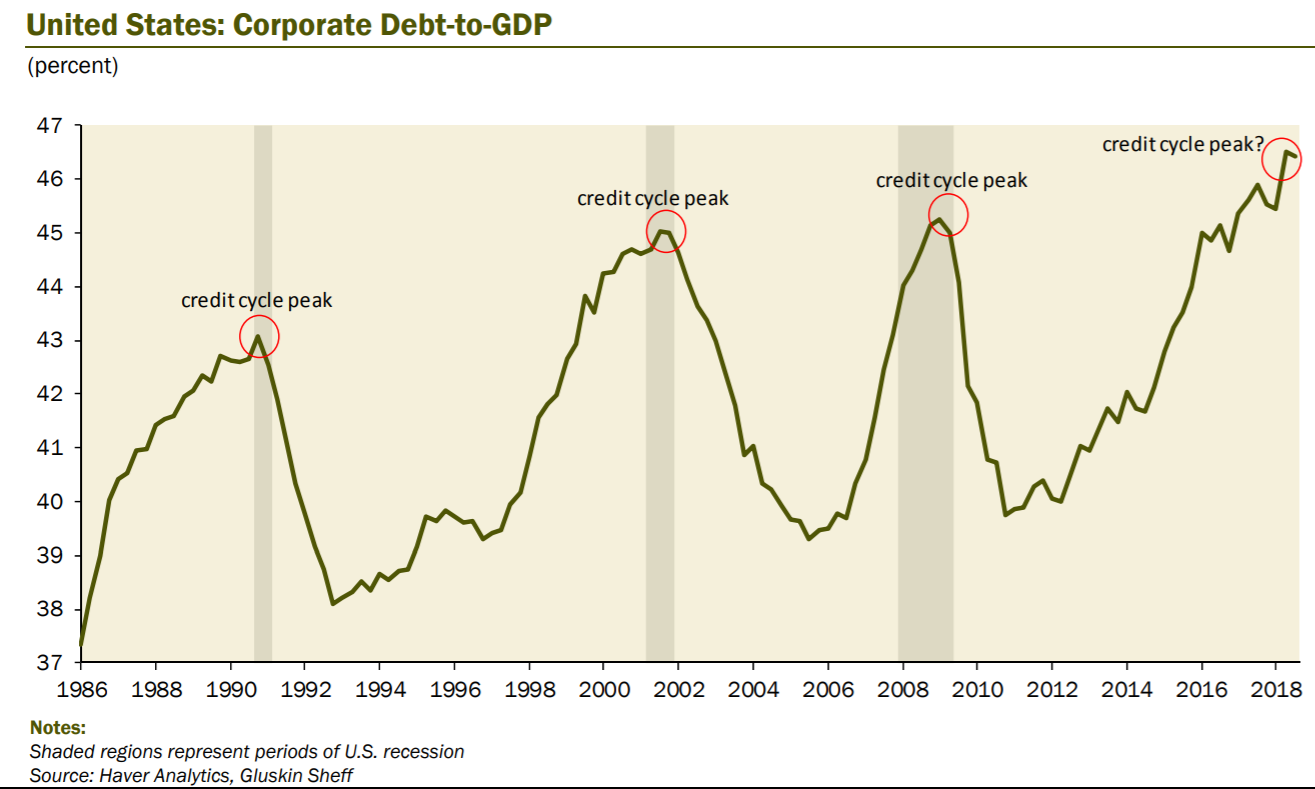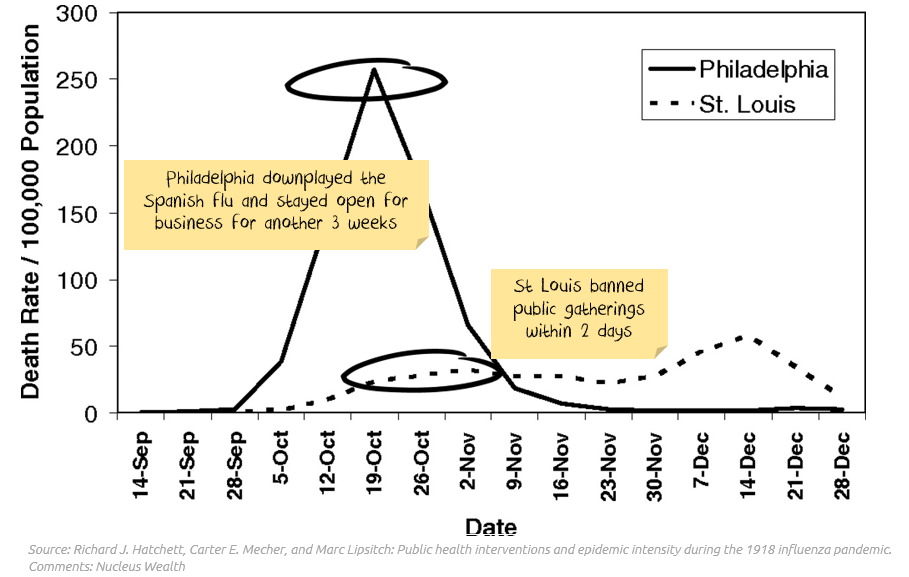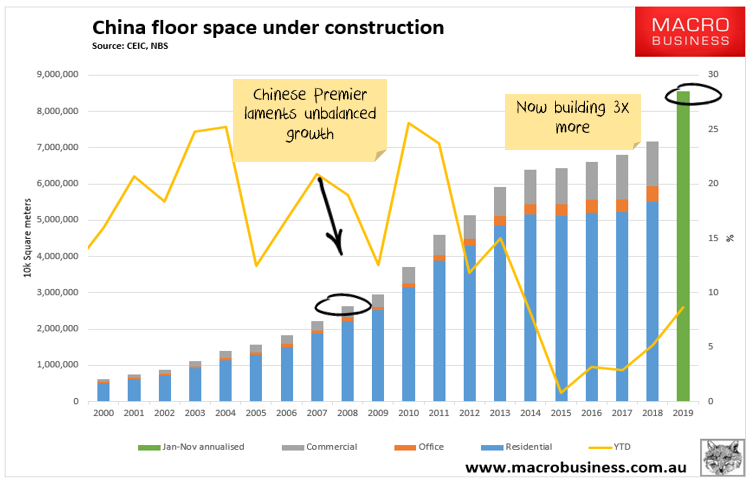It would have been difficult to lose money in January. Bonds, Aussie shares, international shares, residential property, it seemed like every asset was marching higher. Our own funds were no exception, our tactical funds all outperforming benchmarks.
But, by the end of the month, we had thrown in the towel. Share valuations have not been this expensive since the tech wreck. Earnings growth is pretty close to zero. A supply shock is accruing in China. So is a demand shock. There are significant tail risks in corporate debt markets. And I haven’t even got to the threat of a global pandemic.
We took the view it is time to retreat to cash, international currencies and bonds. For most of February so far, the share market has disagreed with our assessment, while the bond and foreign exchange markets signalled their agreement.
We have made a lot of money for investors during the current cycle. In my view, now is not the time to be greedy and to try to squeeze the last drop of performance. Instead, we are taking cover to wait for a cheaper, and potentially much cheaper, opportunity to buy shares.
Other Nucleus funds also had significant gains over the last year. Our International direct share portfolio led with 25.3% returns over the year, our tactical funds ranged between 9.1% for our most conservative Income portfolio to 17.5% for our Growth portfolio.
ASIC requires fund managers to disclaim that past performance is not an indication of future performance. That is especially true of the last twelve months. Returns are overstated as steep falls in share markets late in 2018 that meant 2019 started from a low base.
Truimph of the optimists?
Share markets usually go up. The world belongs to the optimists, regardless of how (frustratingly!) oblivious many optimists are.
The returns over the last twelve months highlight the issue of remaining too conservatively positioned. Anyone huddling in cash following the bloodbath in share markets at the end of 2018 missed the upside of being more active with asset allocation.
So, are Nucleus making the same mistake now by going to cash?
Maybe. But given two significant risks markets are facing, we are prepared to weather some short term regret. The payoff is hedging the most substantial risks we have seen since the financial crisis.
- Global share markets are trading on 20-year valuation highs with very few signs of growth.
- The worst outcome from selling shares now is that we miss out on shares returning to unsustainable “tech-wreck” level valuations.
- The best outcome is we miss a massive drawdown from any one of a range of economic risks.
Non-linear risks
A non-linear risk is one where the downside becomes exponentially worse past a point of no return. Driving along the edge of a cliff is a good analogy. If you were 10 metres away from falling off or 10 millimetres, the outcome is the same: you survived. But go just that little past the edge, and you reach a point of no return.
There are two significant non-linear risks. Maybe neither of them eventuate, and the world will carry on not knowing that it was 10 millimetres away from disaster. But, the chance of either occurring continues to increase with each passing day.
Risk 1: Debt Crisis
We know:
- Corporate debt is at all-time highs
- Many companies run “just in time” inventory and have very little slack in the supply chain
- The end of the corporate debt cycle almost always results in a recession
- There is a supply shock already coming for companies with operations in China from shutdowns and quarantines
- At the same time, there is a demand shock starting to unfold for companies dependent on Chinese demand from closures and quarantines
- Some small companies are already folding, after just a few weeks of China shutdowns
The risk is a wave of company defaults from companies that are overleveraged and reliant on either demand or supply from China.
Debt crises are inherently non-linear. Companies go bust all the time, but don’t create a debt crisis.
However, if (a) loans are being offered too cheaply and (b) there are enough defaults (or one or two large, high profile defaults), then:
- the interest rates increase in the corporate debt market as participants remember the risks
- loans become harder to get and/or rollover
- this will mean other companies will also default
- interest rates will go even higher, loans harder to get
- and so on, spiralling into a debt crisis.
China has already locked in months of weak consumer demand, quarantines and shutdowns. This risk is a clear and present danger to markets – regardless of the further spread of COVID-19.
Risk 2: Global Pandemic
Viruses are the ultimate non-linear risk. The word pandemic literally describes an exponential outbreak of a virus across multiple countries.
The initial stages of an outbreak are basically the only time you have to stop the virus. Once a virus reaches a critical mass of people, it is virtually impossible to stop until it has run its course.
The key at that point is slowing down the virus. The real danger is when hospitals are over-run, and health professionals succumb. With limited staff, beds or respirators, death rates skyrocket.
The relative response of two US cities in the 1918 flu pandemic is instructive:
Northern Hemisphere developing countries
Once the virus reaches numbers into the hundreds in a region, then quarantines, bans on public gathering and shutdowns are the only hope to slow the progress and save lives.
There is a significant (and necessary) economic cost to these measures.
This step China has already reached. And not just in the Hubei province, right across China bans and quarantines are restricting the economy.
South Korea and Iran are very likely to reach the same point this week.
Our base case is now that many Northern Hemisphere developing countries will end up in the same position.
Southern Hemisphere / Equatorial developing countries
I’m not sure about tropical countries. It may be that warm weather and sunshine is enough to slow the virus:

Our base case is equatorial countries avoid significant outbreaks. But, our faith in that forecast is low. If one of the above succumbs to an epidemic, then it is likely they all will.
Even if contained, there is a relatively high likelihood that in four months, when the southern hemisphere winter starts, other developing countries will see outbreaks.
Northern Hemisphere developed countries
This is the key economic risk.
The handling of cases in developed countries to date has not inspired confidence (except in Singapore). There are many cases of infected patients being sent home from hospitals on multiple occasions before being diagnosed.
Many developed countries are still not even testing for COVID-19. It is difficult to find cases when you aren’t looking.
Italy is the canary in the coal mine. Cases have exploded in the last few days and whether the virus can still be contained in Italy will likely indicate what other developed countries can expect.
A pandemic through developed countries is not yet our base case. But it is not far off. It is a real and significant risk.
Health Outcomes
Indications are that COVID-19 kills about 1-2% of people who it infects.
The chart above is from a Chinese study of identified cases. Potentially this number is much lower as many patients only have very mild (or no) symptoms and so may never have been diagnosed.
If two-thirds of carriers have never been diagnosed (as some have estimated), then the death rate may be well below 1%.
This is a two-edged sword. The good news is fewer people who catch the virus will die. The bad news is far more people would already have the virus, which means a global pandemic may already be unavoidable.
Hong Kong’s leading public health epidemiologist suggested that, in a pandemic, about 60% of the world’s population would be affected. If 50% of carriers are undiagnosed, we are talking 50m people dead. 60m more critically ill for weeks. 320m severely affected.
Economic Outcomes
The most common bullish argument is:
- COVID-19 is just a bad version of the flu
- There will be so much fiscal and monetary stimulus that stock markets will go higher
The market has been happy to “look across the valley” of any downturn from the virus. On the other side of the valley, it expects a massive Chinese stimulus package and bid ups shares on the expectation.
Perversely, some days it seems the market is pricing more lousy news as meaning the Chinese stimulus package will need to be even bigger. Which will be even better for the shares involved.
The risk is that China can’t stimulate much harder – they are already building at incredible levels:
And so it is likely the stimulus won’t be enough to replace the lost demand. After being through a complete quarantine/lockdown, my expectation is consumer spending will be muted for months and maybe even years.
If a gigantic government stimulus eventuates, then we will reconsider based on how expensive the market is and how targetted the stimulus is. At the moment, with an expensive market and unknown stimulus, discretion is the better part of valour.
Where to avoid
Sectors and countries I’m looking to avoid have some key elements:
- Exposure to Chinese demand
- Reliant on Chinese and global tourism
- Companies with too much debt
- Countries with consumers carrying with too much debt
- Countries with too much debt not denominated in their local currency
- Cyclical companies, like resources or capital equipment which tend to rise more quickly in booms but fall more rapidly in busts
- Exposure to Chinese students
- Banks exposed to the above
Australia ticks almost every box above. Europe ticks a lot. Canada has a decent spread.
Summary is:
- A hit to world growth is already locked in from current shutdowns
- There are likely to be at least 2-3 months of restrictions, so a greater economic impact is likely
- We expect Chinese stimulus to underwhelm
- Potential for a deep recession if global pandemic eventuates
- Potential for a deep recession if corporate debt crisis eventuates
Going to ground
Our portfolios have “gone to ground” over February, selling stocks and investing in bonds/cash/international currencies. Our tactical growth fund has been close to 50% underweight equities for a number of weeks. This is a significant deviation and one that we have not undertaken lightly.
In our tactical portfolios, we own cash, bonds, international shares and Australian shares. We tend to blend these portfolios for clients so that each investor receives an exposure tailored to their own risk and income requirements:
January Performance
If markets shoot higher, then we will underperform, but we think the trade-off is justified. Downside protection is more important at this point in the cycle than chasing stock markets higher.










